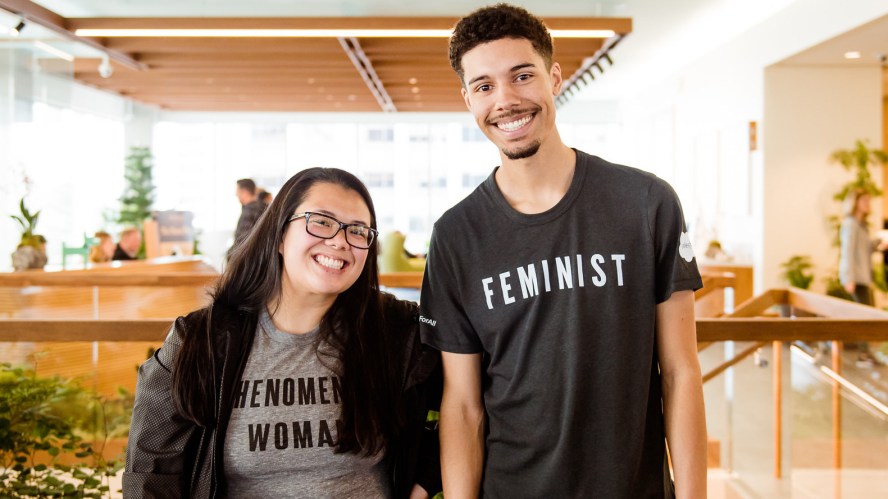Equality is a core value at Salesforce, and a key way we drive equality in our company is by building a culture of belonging where everyone feels seen, heard, and empowered to succeed. Employees who feel their voice is heard at work are nearly five times (4.6X) more likely to perform their best work. Everyone has a role to play in creating a culture of belonging and driving equality in the workplace. That’s where allies come in. In this post, we’ll walk you through what allyship is and how to become an ally.
What is an Ally?
An ally is someone who may not be a member of a community, but supports them. Anyone can be an ally for racial equality. You don’t need to identify entirely with a community or share the same interests or background. It doesn’t mean that you need to agree on every single issue. But it does mean that as an ally, you support and show up for others. It’s a lifelong journey of learning.
At Salesforce, we see allies on a journey that range from curious to courageous. At the curious stage, allies want to learn more about how to become a better ally, but may not know which questions to ask. Further along the journey, allies become courageous, ready to use their platform to advocate for a community out in the world. Below, find a look at this journey in action.
How to be an ally: Your journey from curious to courageous

We see allies on a journey that range from curious to courageous. Allies may be on all stops along this journey. Some may be curious — they want to learn more about how to become a better ally, but may not know which questions to ask. Others may be further along the journey and be courageous allies, ready to use their platform to advocate for a community. Let’s take a look at this ally journey in action:
1. Curious allies ask questions
The ally journey begins by asking about others’ experiences with the understanding that it’s okay to be vulnerable and admit you don’t know everything. Learn to be comfortable with being uncomfortable. Ask questions. We can’t know or truly understand until we ask. Understand, too, that as humans, we all have biases, and we can educate ourselves on the impact of unconscious bias as an early step on our journey.

Start with a sincere curiosity to learn about a community — seek out members of underrepresented minorities or marginalized groups either through conversations, watching a documentary, reading a book, or scheduling a coffee chat. Be mindful and remember that not everyone from an underrepresented community wants to be a spokesperson – ask questions within relationships that feel sincere to both of you and consider asking leaders from your employee resource group, if you have them.
Here are some opening questions to get you started on your journey:
- “What does it mean to be an ally?”
- “What’s the preferred term for ____ in your community?”
- “What can I read or watch to understand your lived experience?”
2. Curious allies listen to other communities
After we ask, it’s important to practice deep and empathetic listening. Listen to learn, not to respond. Practice pausing and reflecting. Be intentional about making space for others. As we do this, we begin to develop empathy for other communities by understanding their lived experience.

Here are some ideas to get you started on your listening journey:
- “Can you tell me what a typical day is like for you?”
- “What makes you feel included and empowered?”
- “What do you wish I knew about your lived experience?”
3. Courageous allies show up for communities
Showing up for our communities is a key step to being an ally. It shows commitment and gives allies a chance to better understand a particular affinity group.

and allies attend the 2019 Martin Luther King Jr. march in San Francisco
At Salesforce, the journey of our allyship growth began in 2017, when Salesforce employees led by BOLDforce, our Black employee resource group, attended the Martin Lurther King Jr. march in San Francisco. One hundred employees showed up, most of whom identified as black.
Two years later, after evangelizing the message of allyship, 1,200 employees showed up, mostly allies. And in 2020, we had 2,000 participants in 17 global regions. This was a significant moment, particularly for our underrepresented employees. After seeing so many colleagues show up as allies, many employees felt this support created a deeper sense of belonging for them at work.
Here’s how you can start to show up:
- “What meetings or events can I attend to support you?”
- “What are some causes I can show up to by donating and supporting?”
- “What can I do as an ally?”
4. Courageous allies speak up and elevate communities
Now that you’re equipped with a better understanding of a community, it’s time to move along the journey by being brave and courageous. Use your platform to speak up for a community — whether it’s on stage, in a meeting, or on social media.

At Salesforce, we host an annual racial equality summit that features professionals from typically underrepresented communities on stage. We also practice inclusive meetings to ensure everyone is seen and valued and often use our platforms such as social media or our public lobby screens to advocate for communities that have been discriminated against.
Here are some ways you can use your voice to speak up:
- If you notice that someone is speaking over another person in a meeting, intentionally or not, speak up and practice inclusive meetings.
- If your team is planning to go to a happy hour — speak up if the activity is not inclusive of everyone’s religious beliefs, habits, or parental responsibilities. Note: here are 5 inclusive team bonding activities.
- Point out an action that discriminates against a community when it happens.
We are all on this journey — learning and moving forward together. Regardless of where you may be on this journey, we ask everyone to be intentional and deepen their understanding of others as they move forward. We encourage you to be brave, get comfortable with being uncomfortable, and take action.
This video demonstrates the power of allies, both in the workplace and in our everyday lives:
Learn more about our ally strategies by taking our free Trailhead module.




![[Customer service career path]: A picture of Shonnah Hughes smiling in her maroon Serviceblazer hoodie](https://www.salesforce.com/blog/wp-content/uploads/sites/2/2024/06/Serviceblazer-Shonnah-Hughes.jpg?w=128&h=96&crop=1&quality=75)























